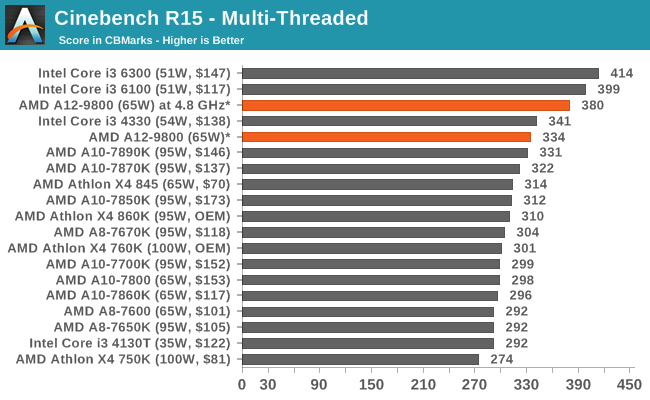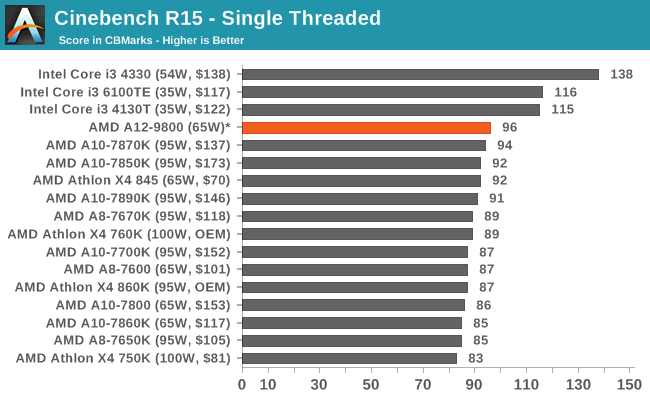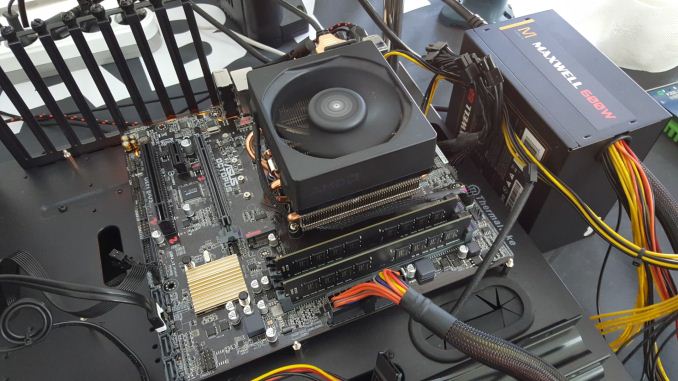AMD 7th Gen Bristol Ridge and AM4 Analysis: Up to A12-9800, B350/A320 Chipset, OEMs first, PIBs Later
by Ian Cutress on September 23, 2016 9:00 AM EST
Over the last two weeks, AMD officially launched their 7th Generation Bristol Ridge processors as well as the new AM4 socket and related chipsets. The launch was somewhat muted, as the target for the initial launch is purely to the big system OEMs and system integrators, such as Lenovo, HP, Dell and others – for users wanting to build their own systems, ‘Product-in-Box’ units (called PIBs) for self-build systems will come at the end of the year. We held off on the announcement because the launch and briefings left a number of questions unanswered as to the potential matrix of configurations, specifications of the hardware and how it all connects together. We got a number of answers, so let’s delve in.
The CPUs
The seven APUs and one CPU being launched for OEM systems spans from a high-frequency A12 part using the 7th Generation microarchitecture (we call it Excavator v2) to the A6, and they all build on the Bristol Ridge notebook parts that were launched earlier in the year but focused on the desktop this time around. AMD essentially skipped the 6th Gen, Carrizo, for desktop as the design was significantly mobile focused – we ended up with one CPU, the Athlon X4 845 (which we reviewed), with DDR3 support but no integrated graphics. Using the updated 28nm process from TSMC, AMD was able to tweak the microarchitecture and allow full on APUs for desktops using a similar design.
The full list of processors is as follows:
| AMD 7th Generation Bristol Ridge Processors | |||||
| Modules/ Threads |
CPU Base / Turbo (MHz) |
GPU | GPU Base / Turbo (MHz) |
TDP | |
| A12-9800 | 2M / 4T | 3800 / 4200 | Radeon R7 | 800 / 1108 | 65W |
| A12-9800E | 2M / 4T | 3100 / 3800 | Radeon R7 | 655 / 900 | 35W |
| A10-9700 | 2M / 4T | 3500 / 3800 | Radeon R7 | 720 / 1029 | 65W |
| A10-9700E | 2M / 4T | 3000 / 3500 | Radeon R7 | 600 / 847 | 35W |
| A8-9600 | 2M / 4T | 3100 / 3400 | Radeon R7 | 655 / 900 | 65W |
| A6-9500 | 1M / 2T | 3500 / 3800 | Radeon R5 | 720 / 1029 | 65W |
| A6-9500E | 1M / 2T | 3000 / 3400 | Radeon R5 | 576 / 800 | 35W |
| Athlon X4 950 | 2M / 4T | 3500 / 3800 | - | - | 65W |
AMD’s mainstream processors will now hit a maximum of 65W in their official thermal design power (TDP), with the launch offering a number of 65W and 35W parts. There is the potential to offer CPUs with a configurable TDP, however much like the older parts that supported 65W/45W modes, it was seldom used, and chances are we will see OEMs stick with the default design power windows here. Also, the naming scheme: any 35W part now has an ‘E’ at the end of the processor name, allowing for easier identification.
As part of this review, we were able to snag a few extra configuration specifications for each of the processors, including the number of streaming processors in each, base GPU frequencies, base Northbridge frequencies (more on the NB later), and confirmation that all the APUs launched will support DDR4-2400 at JEDEC sub-timings.
| AMD 7th Generation 65W Bristol Ridge Processors | |||||
| Modules/ Threads |
CPU Base / Turbo (MHz) |
GPU SPs |
GPU Base / Turbo (MHz) |
Northbridge Base (MHz) |
|
| A12-9800 | 2M / 4T | 3800 / 4200 | 512 | 800 / 1108 | 1400 |
| A10-9700 | 2M / 4T | 3500 / 3800 | 384 | 720 / 1029 | 1400 |
| A8-9600 | 2M / 4T | 3100 / 3400 | 384 | 655 / 900 | 1300 |
| A6-9500 | 1M / 2T | 3500 / 3800 | 384 | 720 / 1029 | 1400 |
| Athlon X4 950 | 2M / 4T | 3500 / 3800 | - | - | 1400 |
| AMD 7th Generation 35W Bristol Ridge Processors | |||||
| Modules/ Threads |
CPU Base / Turbo (MHz) |
GPU SPs |
GPU Base / Turbo (MHz) |
Northbridge Base (MHz) |
|
| A12-9800E | 2M / 4T | 3100 / 3800 | 512 | 655 / 900 | 1300 |
| A10-9700E | 2M / 4T | 3000 / 3500 | 384 | 600 / 847 | 1300 |
| A6-9500E | 1M / 2T | 3000 / 3400 | 256 | 576 / 800 | 1300 |
The A12-9800 at the top of the stack is an interesting part on paper. If we do a direct comparison with the previous high-end AMD APUs, the A10-7890K, A10-7870K and A10-7860K, a lot of positives end up on the side of the A12.
| High-End AMD APU Comparison | |||||||
| A12-9800 | A10-7890K | A10-7870K | A10-7860K | A10-9700 | |||
| MSRP | - | $165 | $137 | $117 | - | ||
| Platform | Bristol Ridge | Kaveri Refresh | Bristol Ridge | ||||
| uArch | Excavator v2 | Steamroller | Steamroller | Steamroller | Excavator v2 | ||
| Threads | 2M / 4T | 2M / 4T | 2M / 4T | 2M / 4T | 2M / 4T | ||
| CPU Base Freq | 3800 | 4100 | 3900 | 3600 | 3500 | ||
| CPU Turbo Freq | 4200 | 4300 | 4100 | 4000 | 3800 | ||
| IGP SPs | 512 | 512 | 512 | 512 | 384 | ||
| GPU Turbo Freq | 1108 | 866 | 866 | 757 | 1029 | ||
| TDP | 65W | 95W | 95W | 65W | 65W | ||
| L1-I Cache | 192 KB | 192 KB | 192 KB | 192 KB | 192 KB | ||
| L1-D Cache | 128 KB | 64 KB | 64 KB | 64 KB | 128 KB | ||
| L2 Cache | 2 MB | 4 MB | 4 MB | 4 MB | 2 MB | ||
| DDR Support | DDR4-2400 | DDR3-2133 | DDR3-2133 | DDR3-2133 | DDR4-2400 | ||
| PCIe 3.0 | x8 | x16 | x16 | x16 | x8 | ||
| Chipsets | B350 A320 X/B/A300 |
A88X A78 A68H |
A88X A78 A68H |
A88X A78 A68H |
B350 A320 X/B/A300 |
||
The frequency of the A12-9800 gives it a greater dynamic range than the A10-7870K (having 3.8-4.2 GHz, rather than 3.9-4.1), but with the newer Excavator v2 microarchitecture, improved L1 cache, AVX 2.0 support and a much higher integrated graphics frequency (1108 MHz vs. 866 MHz) while also coming in at 30W less TDP. The 30W TDP jump is the most surprising – we’re essentially getting better than the previous A10-class performance at a lower power, which is most likely why they started naming the best APU in the stack an ‘A12’. Basically, the A12-9800 APU will be an extremely interesting one to review given the smaller L2 cache but faster graphics and DDR4 memory.
A Wild Overclocker Appears!
Given that technically the systems with the new APUs have been released for a couple of weeks, some vendors have their internal enthusiasts play around with the platform. Bearing in mind that AMD has not announced any formal overclocking support on these new APUs, NAMEGT, a South Korean overclocker with ties to ASUS, has pushed the A12-9800 APU to 4.8 GHz by adjusting the multiplier. To do this, he used an unreleased ASUS Octopus AM4 motherboard and AMD’s 125W Wraith air cooler (which will presumably be bundled with PIBs later in the product cycle).
NAMEGT ran this setup on multithreaded Cinebench 11.5 and Cinebench 15, scoring 4.77 and 380 respectively for a 4.8 GHz overclock. If we compare this to our Bench database results, we see the following

For Cinebench 15, this overclocked score puts the A12-9800 above the Haswell Core i3-4360 and the older AMD FX-4350, but below the newer Skylake i3-6100TE. The Athlon X4 845 at stock frequencies scored 314 while running at 3.5 GHz, which would suggest that a stock A12-9800 at 3.8 GHz would fall around the 340 mark.

(Since writing this, a preview by Korean website Bodnara, using the A12-9800 in a GIGABYTE motherboard, scored 334 for a stock Cinebench 15 multithreaded test and 96 for the single threaded test. We've added this result for perspective.)

When we previously tested the Excavator architecture for desktop on the 65W Athlon X4 845, overclocking was a nightmare, with stability being a large issue. At the time, we suspected that due to the core design being focused towards 15W, moving beyond 65W was perhaps a bit of a stretch for the design at hand. This time around, as we reported before, Bristol Ridge is using an updated 28nm process over Carrizo, which may have a hand in this.
When we asked AMD about overclocking details on the new APUs, the return reply was along the lines of ‘No OEM systems at this time will be unlocked, and no official comment on the individual units. More details will be released closer to the platform launch for DIY users’.












122 Comments
View All Comments
jardows2 - Friday, September 23, 2016 - link
Really looking forward to some actual benchmarks. I really am itching to build a new office computer, and right now, the i3-6100 is the only realistic chip, since I won't be doing much gaming on the system. If the new A12 and A10 can even come close to matching the i3 in CPU tasks, I'd be more than happy to snag that up, as the graphics will be nice, and the upgradability to Zen later if that processor pans out.Danvelopment - Saturday, September 24, 2016 - link
I'm writing an article on that at the moment (different site built around the economics of modern tech). Conclusion is unless you need specific Skylake tech on a desktop (m.2, DDR4, ECC, IGP, SGX, MPX or AVX2), get an Ivy Bridge i5/i7. Ex-lease Ivy machines are pretty much being sold for pennies these days (less than a new Pentium machine) and a quad Ivy i5/i7 will almost always demolish a Skylake i3 on the CPU side.Use the leftover cash for a couple SSDs and beer.
serendip - Saturday, September 24, 2016 - link
And so comes the end of the desktop computer, as people refurbish old computers and use them for years instead of buying new ones every year. That Ivy i5 system paired with lots of cheap RAM and a cheap SATA SSD would be more than fast enough for office tasks for years to come.Could be good for AMD though. They could make good-enough APUs for mainstream usage at a price point Intel can't touch. It's a race to the bottom and AMD could conceivably win.
LordanSS - Saturday, September 24, 2016 - link
Still rocking my 3770k.Skylake wasn't a good enough performance bump for my use cases, considering platform price. Kaby Lake has no IPC boost, and who knows when Cannonlake will arrive.
Waiting on Zen to arrive so I can take a look at benchmarks. Even if it's "slower" than Skylake, if the platform cost is right it would be a quite viable option.
Danvelopment - Sunday, September 25, 2016 - link
Precisely, I just overclocked my 2500K to 4.5GHz the other day and it will definitely last me until Intel gets its act together and puts a focus on performance improvements again.If AMD were competitive, Intel would probably be pushing a lot more performance on successive generations. Instead they're cashing in by shrinking dies and moving more components on die, while only incrementally improving performance.
So really it's a good thing, suddenly competing with the secondhand market will hopefully see a large performance boost in future generations.
patrickjp93 - Tuesday, September 27, 2016 - link
@Danvelopment Please take a look at Agner Fog's x86 instruction latency tables. Intel can't squeeze blood from a rock and make instructions take less than 1 cycle. No one can.patrickjp93 - Tuesday, September 27, 2016 - link
Continuing from the above, that's why SIMD and MIMD instructions were created.Danvelopment - Tuesday, September 27, 2016 - link
So you're saying we've hit the limit for processor performance and there's nothing new anyone can do?I find that hard to believe, especially as innovation is not required to increase performance, hell if they were desperate they could bring i3 to a quad minimum and flop four more cores into 5 and 7 and call it a day. It's not innovation but it's a significant increase in performance potential.
Instead we've gone from a 216mm2 die to a 122mm2 die.
If it were neck and neck, Intel wouldn't look at AMD and go, "whelp, nothing we can do".
Danvelopment - Tuesday, September 27, 2016 - link
216 is Sandy Bridge and 122 is Skylake.jardows2 - Monday, September 26, 2016 - link
Where can I find these "pennies" for Ivy i5? Best I'm finding is on fleaBay for about $200 shipped. With 4GB RAM and too small of a hard drive. After I upgrade the hard drive and RAM to where I need, I have a used computer that costs only about $40 less than if I build a new i3 system. And demolish? I'm not so sure about that:http://www.anandtech.com/bench/product/1783?vs=702
Beat? Yes, but I wouldn't say demolish.